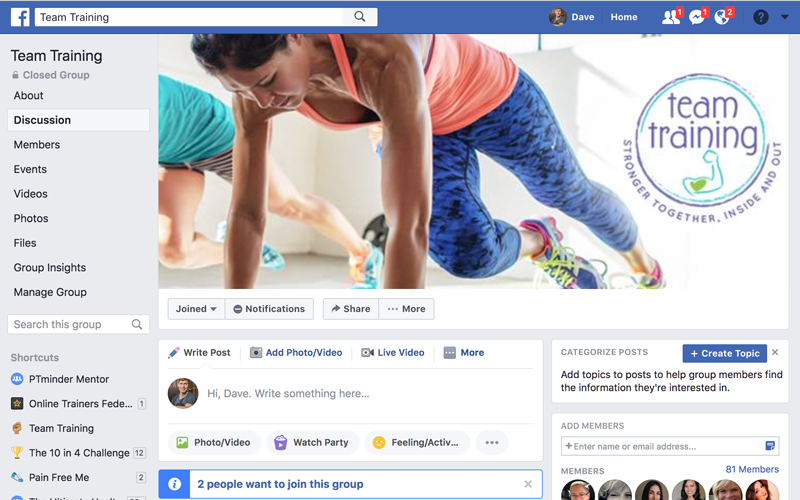Just like with any business, the more you're prepared to branch out and try new things, the more likely your brand is to grow. Don't get stuck in a rut as a personal training, simply offering the same old services. Maybe there's a better business model you should try?

What exactly is a personal training business model?
A business model is basically an explanation of how you structure your business to generate a profit. So, your personal training business model outlines how you will offer your services and what you will charge in return for the help you offer.
Business models aren't set in stone, so you may find yourself with a completely different business model from your competitors, or one that is pretty similar.
No matter what model you choose though, at the core your business model must be clear, simple and able to grow over time. It is also important that your business is able to serve a market that is both able to make you money, and able to grow with your business.
While there are a number of different options you can choose from, let's look at the top 5 personal training business models. Try these out. Mix and match. Find what works for you.
1. Private In-Person Training
When most people think of personal training as a career, this is what they envision. Many clients especially love private training because it gives them the opportunity to work individually with their trainer. They like the attention and the accountability that brings.
Private training sessions are one-on-one, and can be as short as 20 minutes or as long as 2 hours, depending on the client. Basically, you, the instructor would start by meeting with the client to set individual goals and create a program.
Don't get stuck in the mindset that a one-on-one session has to be an hour long. Do your clients really need an hour with you? Could you help more people (and make more money) by assigning them individual work to do on their own before you begin, say, a 30-minute session with them?

Private in-person training is an easy business to build, but has limited earning potential
The downside of private personal training is its limited earning potential. Since you’re sharing your time with clients, this business model can be pretty exhausting. There are only so many hours in a week to train clients, so your maximum revenue is capped.
PRICE POINT: $40-$100 per session
2. Group Training
Group training definitely isn’t new to the exercise world, and is used for fitness programs ranging from boot camps, to Pilates, to yoga, and even sport-specific training.
The basic principle of the group training business model is simple: Clients pay a membership fee for a series of structured group classes . Usually, the group training ratio is 10 to 20 clients per instructor, but you can determine the size and length of the classes and align these with your price point.
Group training is a great way to serve many clients at the same time, which in turn saves you time. And for many clients, the community that comes along with group training makes their experience more enjoyable.
A positive of group training is the opportunity to upsell these clients into more expensive one-on-one sessions or semi-private classes with you.
One downside: This training model has plenty of competition since virtually anyone can start a class in a park, gymnasium, or in their own backyard. You can easily end up in a price-war with other personal trainers.
PRICE POINT: $10-$20 per class
3. Semi-Private Training
Semi private training is the midpoint between private and group training. The sessions usually have far fewer clients than group training (3-5 clients per instructor), and while they’re still not completely individualized, they do offer more customization than group training.
This type of training model especially appeals to clients who have specific needs or goals (e.g. moms getting in shape after pregnancy, runners training for an upcoming race, etc.), and are therefore able to work through exercises that are very similar to their peers.

Semi-private training allows you to earn more per hour than you could during one-on-one personal training sessions
Semi private training is usually very profitable, because it combines the advantages and the community of group training with the individualized approach of private training. This gives clients a great all-round experience which boosts your retention rate, and allows you to charge a higher price than you could in large group classes.
To stay profitable though, it’s up to you to set a minimum number of clients per session. You do not want to offer semi-private training prices and end up with only 1 or 2 clients in that session. Set boundaries and stick to them. This is your business - It must earn money!
PRICE POINT: $20-$50 per session
4. Online Coaching
Online coaching is a relatively new training model, but is one that is growing VERY quickly. The developments in online content sharing and digital media have blown the potential for online coaching wide open.
Usually in online coaching, instructors interact with clients via email, phone, Skype or another video calling service. There is typically some face-to-face time, even thought it's done at a distance, often in different countries or completely around the world.
Some online programs also include a forum or Facebook group where clients can communicate with each other and ask you questions.

My online community is called Team Training - letting my clients interact with one another and answer each other's questions saves me loads of time!
Online training is great because it gives you plenty of time flexibility, and it allows you to recruit clients internationally. You can also use many strategies to automate the process, thereby allowing you to work with hundreds of clients at a given time.
However, it takes a lot more marketing and sales experience to grow an online client base than one in your local community. When you're selling in-person, many people will buy from you because they know you. They want to be around you. They want your attention. This is harder to achieve when you aren't face-to-face with your prospective clients.
Also, it’ can be harder to generate commitment when you’re not seeing your clients in-person. Finding the right accountability systems is crucial.
PRICE POINT: $50-$500 per month (Depending on the level of personal programming and the amount of face time you offer)
5. Hybrid Training
Hybrid training basically refers to any cross between the online training model and one of the face-to-face models we've covered.
For example, you can supplement a weekly group boot camp with an online resource centre that involves at-home-exercise videos, a meal planning regimen, and an individualized client goal setting. This allows clients to access your services both at-home and in-person.

Hybrid training let's you scale up your business without necessarily working more hours
This strategy allows you to use your existing in-person clients to build up your online base. Here's a detailed guide on building your hybrid training business.
While it definitely requires a lot more effort than simply running a traditional boot camp or fitness class, offering a hybrid system can translate into increased and more regular income, better results for your clients, a loyal community of followers, and it give you an edge over your competition.
One downside is that some clients may not want to participate online. This leaves you with decisions to make about how to deal with some clients who are "in" and some who are "out." It can be tempting to offer special treatment to those who choose not to participate online, but this can add up to additional work hours for you without getting paid.
PRICE POINT: Varies depending on what online and in-person services you're including
Conclusions
If you really want to grow your fitness business, don't settle for the same old models that can leave you time-strapped and maxed out revenue-wise. How can you combine 2 or 3 of the options presented here to earn more while working less?




